Events of Saturday 6th February 2016
By train to Llandudno
Although it was raining quite hard at home when I got up, I decided I would take the first bus to Wolverhampton and travel to Llandudno (a favourite destination) by train.
The first departure from Wolverhampton was an Arriva Cross Country to Manchester which I took as far as Stafford. Whilst waiting for the following London Midland Liverpool train, I was able to study the historical pictures displayed in the waiting room.
 A 1938 view of the north end of Stafford, with the Wellington line (long gone) curving to the left, the four tracks to Crewe in the centre and the Uttoxeter line (long gone) curving to the right.
A 1938 view of the north end of Stafford, with the Wellington line (long gone) curving to the left, the four tracks to Crewe in the centre and the Uttoxeter line (long gone) curving to the right.
The London Midland Class 350 made good time to Crewe. As we slowed down into platform 11, I spotted a steam locomotive outside the Locomotive Storage building. From the brief glimpse, I took it to be 'Royal Scot', which I later confirmed. Since I had a while to wait before my connection to Chester, I decided to have a walk down Gresty Road (it was still raining hard). Leaving the station, there was smoke rising from the north side of the Nantwich Road bridge, so the steam locomotive had apparently moved down, ready to shunt onto its steam special train.
When I first visited Gresty Road, it was home to British Railways Signal Workshops, housed mainly in various LNWR-built buildings. I had a number of business meetings here when we were supplying telecommunication systems to the railways (briefly described here and here).
The first long block of offices I came to was typically LNWR - functional yet pleasing. I discovered it's now the Technical Investigation Centre for Signalling Projects operated by the consultants 'Atkins' (who have succumbed to replacing the 'A' in 'Atkins' with an upside-down capital 'V', following the same illiterate convention as the car company 'Kia' which I complained about in the post By Rail to Guildford. In case mis-spelling 'Atkins' fails to confuse the visitor sufficiently, they've also turned the whole name through 90 degrees on the sign).
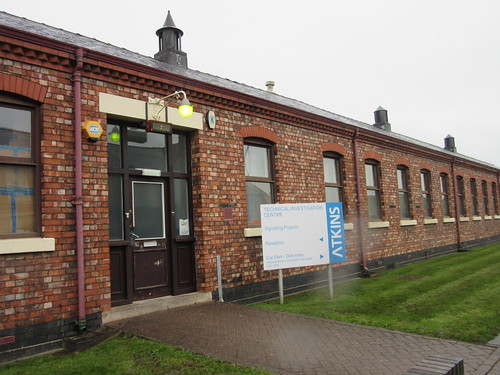 Gresty Road showing Technical Investigation Centre for Signalling Projects operated by the consultants 'Atkins'.
Gresty Road showing Technical Investigation Centre for Signalling Projects operated by the consultants 'Atkins'.
The next group of LNWR buildings are now part of the extensive Unipart Rail site. Opposite, the road leading into a housing estate is called 'Claughton Avenue'. Bowen-Cooke's 4-cylinder 4-6-0 class was introduced in 1913, but named after the then-chairman of the LNWR, Sir Gilbert Claughton (1856-1921)
 Gresty Road showing entrance to Unipart Rail.
Gresty Road showing entrance to Unipart Rail.
I remember when Technical Investigations at Crewe were still part of British Rail. Most of the British Rail signalling workshops were initially privatised as N.R.S. (National Railway Supplies) but it now forms Unipart Rail.
Before turning back, I came to YMCA Crewe. I don't know the history of this modernised building but it certainly looks as if it could have served as a locomens' lodge or similar. Can anyone enlighten me, please?
 YMCA Crewe in Gresty Road.
YMCA Crewe in Gresty Road.
On my walk back to the station, I tried, unsuccessfully, to get a better view of a complete British Railways standard design signal box and colour light signals on the Unipart Rail site, presumably part of a training facility. But I could read the sign on an adjacent training room:-
Welcome to theFor more on 'the Unipart Way', look here.
FACULTY ON THE FLOOR
This is where we ..
..learn to use and improve the principles, systems, tools and techniques of the Unipart Way, access best practice developed elsewhere, and develop new ideas and coach each other in their use.
Approaching the station, I was joined by large numbers of people I guessed were about to join the steam special. I made my way to platform 9 for the 09:23 DMU to Chester, noting that the steam special was due to follow my train after 6 minutes. Maroon-liveried 'West Coast' stock was standing in platform 12 and 'Royal Scot' with its "blood-and-custard" support coach had already drawn forward onto the Down Chester, awaiting the signal to set back onto the train. After a short pause, 'Royal Scot' backed onto its train, sporting a rather 'posh' storm sheet between the trailing edge of the cab roof and the tender.
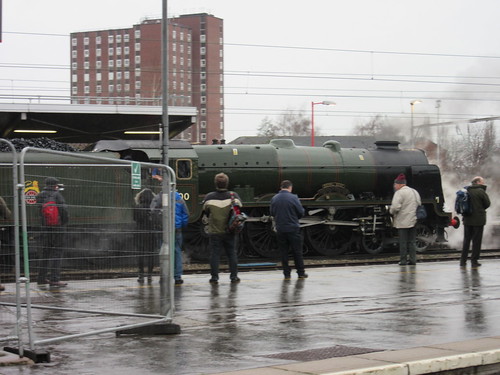 'Royal Scot' (and support coach) backs onto its train in platform 12.
'Royal Scot' (and support coach) backs onto its train in platform 12.
My 2-car DMU arrived and a lot of passengers got off. Then a lot of passengers, including me, got on and we were soon under way for the trip to Chester, where we arrived in the bay platform. A Manchester - Llandudno train was expected in a few minutes, so I positioned myself on platform 3B (the western end of the long down through platform) ready to board the connection and I was soon under way again. I noticed a significant police presence on the station, which was probably due to the following steam train. The middle aged men with cameras hanging around were certainly there for 'Royal Scot'.
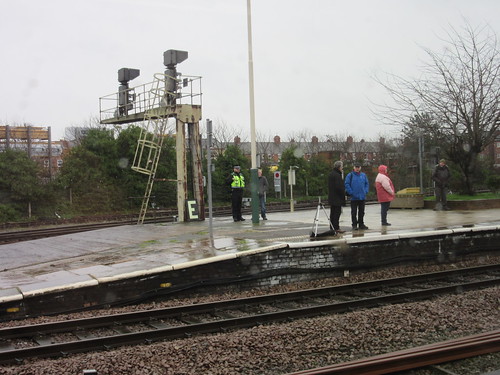 Chester station, waiting for 'Royal Scot' on the Holyhead Private Charter.
Chester station, waiting for 'Royal Scot' on the Holyhead Private Charter.
These enthusiasts could also be seen as I continued to Llandudno Junction, despite the inclement weather, not just at stations but also at various farm gates along the line. I'm afraid I didn't see the steam special again myself after leaving Crewe.
When we paused at Shotton Low Level, I was interested to see rodent traps deployed, because I'd noticed these at Shotton High Level on an earlier trip (8th March 2014), described here.

Shotton Low Level Up Platform (with what appears to be a rodent trap at the base of the lamp post).
We made our scheduled stop at Fflint (more enthusiasts), sped past the now very sad looking 'Duke of Lancaster' (which still has a website here), stopped at Prestatyn then Rhyl. The line is only double track now but a number of signal structures remain cantilevered 2-doll brackets which originally served the 4-track route, now equipped with just one arm. Distant signals are a mixture of colour light and semaphore.
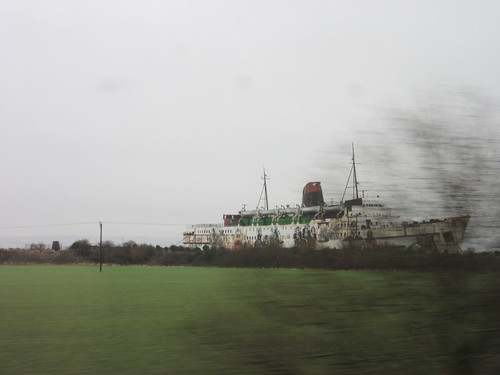 The beached 'Duke of Lancaster'.
The beached 'Duke of Lancaster'.
Beyond Rhyl, we hurried through Abergele in the rain without stopping. When I was young, I always thought this a romantic railway location - four-track with platforms flanking the outer slow lines, Camping Coaches on the seaward side and a dignified LNWR signal box in the middle of it all. Now, it's just 2-track but the down line throws off a loop to the platform line. The facing points leading to the down loop are controlled by two rodding runs - one for the Facing Point Lock, one for the points themselves. The trailing points just need one rodding run to operate the points. Signals around the station remain LMS upper-quadrant. There's a series of posts in this blog about British railway signalling, starting here. Mechanical Operation of Points is described in Part 6. I'm happy to report that, for some reason, the signal box has avoided the worst of the structural alterations I usually complain about and, whilst there are external changes, it looked 'right' (at least from some vantage points). I spotted the expected contingent of steam enthusiasts sheltering under the awning on the Up platform, waiting for 'Royal Scot'.
We stopped briefly at Colwyn Bay which has lost two of the four platforms I remember,together with some of its station buildings, its LNWR glazed screens and is no longer a block post. Between Colwyn Bay and Llandudno Junction, the line was quadruple from 1904 to the 1980s, when it reverted to double track and the A55 Expressway took over the freed-up land. This section of line has a place in railway history for two reasons, which I'll cover in a later post.
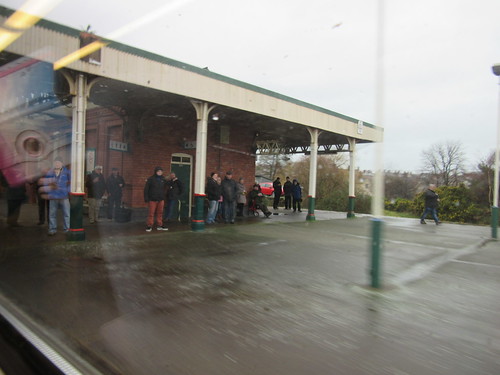 Stopping at Llandudno Junction. Note the steam enthusiasts awaiting the arrival of the following 'Royal Scot'.
Stopping at Llandudno Junction. Note the steam enthusiasts awaiting the arrival of the following 'Royal Scot'.
After another brief stop at 'The Junction', we were soon underway on the final, short leg of our journey. Deganwy is now shown as a 'request stop', and we sailed right through on this occasion.
It was still raining when I got off the train at Llandudno but, undaunted, I set off on foot along Vaughan street to the promenade, crossing the end of the main Victorian shopping street, Mostyn Street, at the delightfully named 'North Western Gardens'.
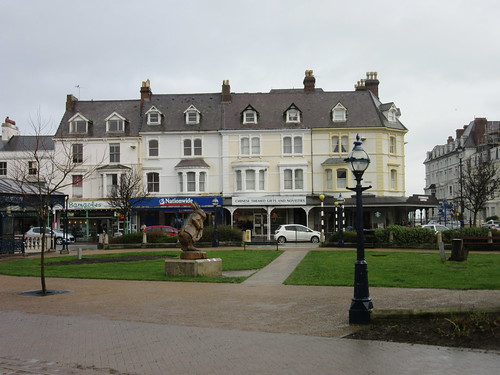 View across North Western Gardens showing the canopied shops in Mostyn Street.
View across North Western Gardens showing the canopied shops in Mostyn Street.
The modern shopping centre, with its large car park, lay a few yards on my right - I don't believe I've ever visited it. Arriving at the promenade near the Imperial Hotel, the curve of the bay between the Little Orme and Great Orme headlands, with the wide pedestrian promenade and the arc of hotels facing the sea, captivated me, as it always has. I happily walked along the promenade towards the pier.
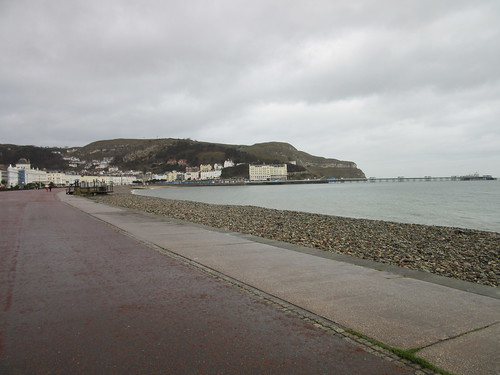 Llandudno: The Promenade looking towards the Great Orme, with the pier on the right.
Llandudno: The Promenade looking towards the Great Orme, with the pier on the right.
Much of the beach is shingle but, near the War Memorial, there is often a sandy stretch until the tide comes in which I was happy to share for a while with a few children and dogs. I then headed away from the sea via St. George's Place, crossed Mostyn Street and continued along Lloyd street to the Town Hall, where the local 'Lions Club' were holding a charity Antiques Fair which I decided to support.
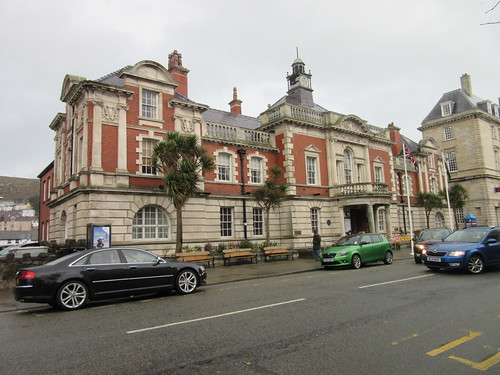 Llandudno: The Town Hall.
Llandudno: The Town Hall.
On one stall, I was surprised to find two black-and-white framed locomotive photographs which I recognised as North British works photographs. One was 'Royal Scot' as built and I commented to the stallholder that I'd seen that very engine (in its rebuilt form) a little earlier. I resisted the strong temptation to purchase it, instead selecting the picture of ill-fated 6399 'Fury'. This experiment in the use of high-pressure steam was abandoned and the locomotive was rebuilt as a conventional 'Royal Scot'.
Near the Town Hall is the famous fish and chip restaurant 'Tribells' so I decided to try their take-away service. Both fish and chips were cooked while I waited (reminding me of fish and chips I had in Sydney on my Round the World One trip in 2001). I started to eat as I walked back to the prom and then sat watching the grey sea. The rain had stopped and the food was excellent. Two seagulls patiently waited on the tarmac a few feet away as I ate - a bit different from a few years ago when they would 'dive-bomb' for food. In view of their good manners, I allowed a small piece of fish to fall as I disposed of the polystyrene tray in a litter bin. I later found notices warning against feeding and littering but there was certainly no litter left!
I made my way back to Mostyn Street to look at some of the shops. Opposite Marks and Spencers, there's the Victoria Centre with its roof-top car park. It's cod-Victorian, not real but does capture some of the atmosphere of the original Victorian shopping arcades, so I don't object to it too much. Many of the shops along Mostyn Street retain Victorian canopies over the pavement (with various degrees of modernisation to keep them watertight). I was soon drawn back to the Promenade and decided to patronise the covered terrace restaurant at the Imperial Hotel, where I enjoyed a toasted teacake and a pot of tea tea with panoramic views of the sea.
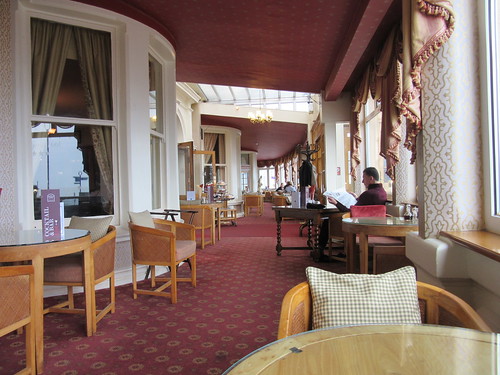 The Terrace at the Imperial Hotel.
The Terrace at the Imperial Hotel.
I'd made a note of trains back to Wolverhampton in time to let me take a bus back to my village, so I reluctantly stirred myself from the Imperial and made the walk to the station, which took around ten minutes. The LNWR station buildings have been quite tastefully modernised, so I took a few pictures before joining the waiting train - a 3-coach 'Class 175' only going to Llandudno Junction before returning to Llandudno.
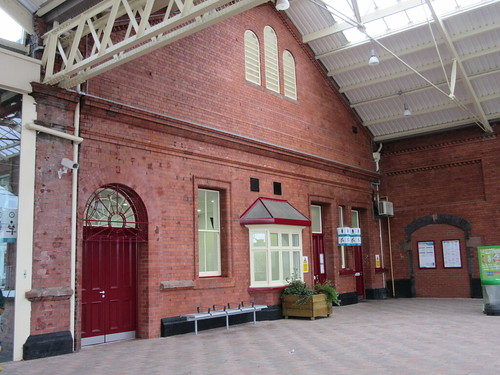 The modernised concourse at Llandudno station.
The modernised concourse at Llandudno station.
I boarded at the front of the train and noticed that the cab door was open, because the Driver was in the passenger section chatting to another railwayman. The friendly driver readily agreed to my taking a couple of pictures of the cab before he left.
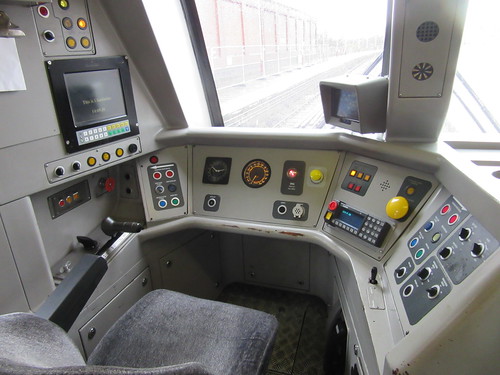 Cab View of 'Class 175' at Llandudno station.
Cab View of 'Class 175' at Llandudno station.
This time, we paused at Deganwy and I took a rather grey picture of Conwy and its ancient castle as we departed. There's a bit about Conwy, its river bridges and castle in my post Trip to Holyhead (Part 2: Llandudno to Holyhead).
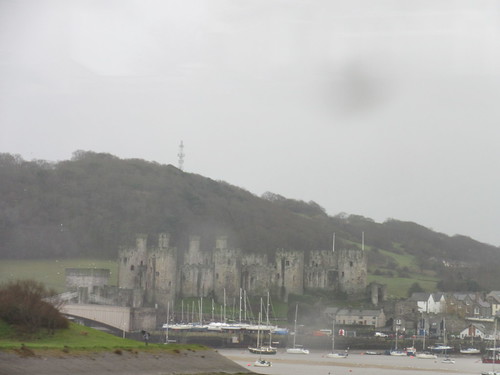 Conwy viewed from Deganwy.
Conwy viewed from Deganwy.
I only had a few minutes to wait before my connection arrived - a 2-car multiple unit which made a few stops before Chester. Here, I had a choice - I could stay on the train which reversed at Chesterand took the former Great Western Railway route through Wrexham and Shrewsbury, calling at Wolverhampton before continuing to Birmingham International. The alternative was a Virgin Voyager service to Crewe, changing to a London Midland Electric Multiple Unit to Wolverhampton. The cheerful Welsh lady Conductor/Guard, having checked my ticket, used her portable ticket issuing machine to confirm the timings via Crewe. She recommended staying on her train, which would arrive at Wolverhampton only about five minutes later than the alternative involving two changes.
But, of course, with my allegiance to the "Nor'Wessie" and its successor the L.M.S., I chose to change at Chester and Crewe. Although I was getting fairly tired, I managed a few more pictures of the imposing station buildings at Chester, before boarding the 'Quiet Coach' at the rear of the Virgin 'Voyager' already waiting in platform 4.
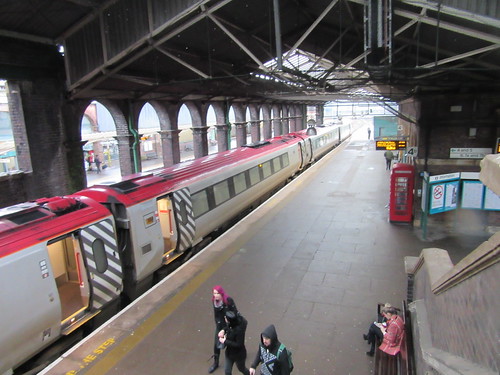 Virgin 'Voyager' from Holyhead to London at Chester.
Virgin 'Voyager' from Holyhead to London at Chester.
Fortunately, the rest of the journey back to Wolverhampton worked well, the bus was on time, so I was back home happy but fairly exhausted. The next day, I was on the footplate at Peak Rail!
Book References
[ 1] '‘British Railways Layout Plans of the 1950’s - Volume 1: ex-LNWR main line, Euston to Crewe’ (Signalling Record Society) ISBN: 1 873228 00 7.
[ 2] ‘British Railways Layout Plans of the 1950’s - Volume 10: LNW Lines in North Wales, Chester and Wirral areas’ (Signalling Record Society) ISBN: 1-873228-12-0.
[ 3] 'An Historical Survey of Chester to Holyhead Railway Track Layouts and Illustrations' by V. R. Anderson and G. K. Fox (Oxford Publishing Co.) ISBN 0 86093 216 8.
[ 4] ‘Along LMS Routes’ by Bill Hudson, Volume 1 Central & Western Divisions (Headstock Publications) ISBN 0 9512793 4 3.
Related articles in this blog
A Trip to the Seaside (Part 1).
A Trip to the Seaside (Part 2).
Trip to Holyhead (Part 1: Crewe to Llandudno).
Trip to Holyhead (Part 2: Llandudno to Holyhead).
The Holyhead to Crewe Railway Line.
Llandudno.
Llandudno Railway Station.
My pictures
Stafford Area rail.
Crewe Area rail.
North Wales Line (Crewe - Llandudno).
Llandudno (pictures around the town).
